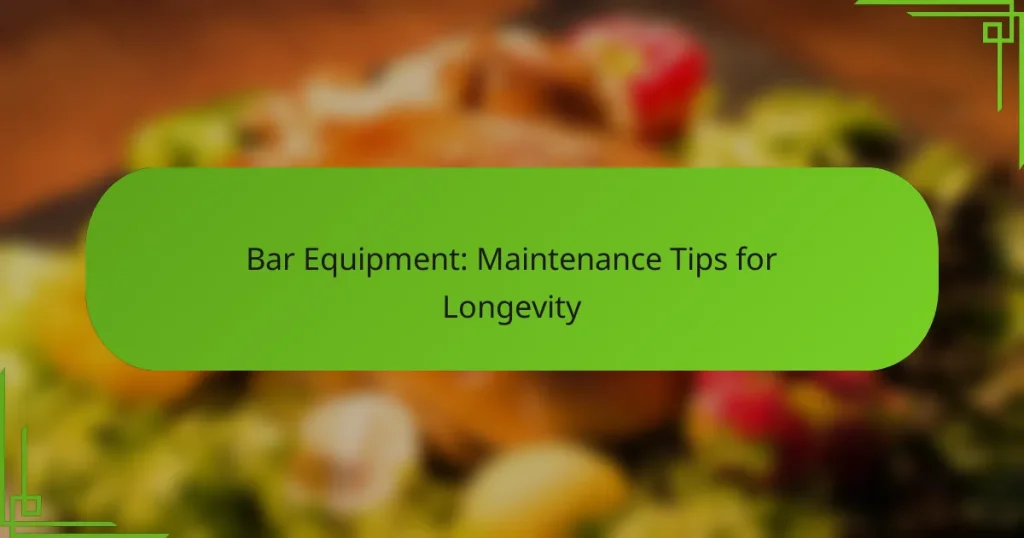Maintaining bar equipment is crucial for ensuring longevity and optimal performance in a bustling environment. By establishing regular cleaning routines, proper storage, and routine inspections, bar owners can prevent breakdowns and enhance efficiency. Prioritizing quality products and monitoring usage patterns further supports the durability of essential tools.

What are essential maintenance tips for bar equipment in Los Angeles?
Essential maintenance tips for bar equipment in Los Angeles include establishing regular cleaning routines, ensuring proper storage, and conducting routine inspections. These practices help extend the lifespan of equipment and maintain optimal performance in a busy bar environment.
Regular cleaning schedules
Implementing regular cleaning schedules is crucial for maintaining bar equipment. Daily cleaning of surfaces and equipment prevents the buildup of grime and bacteria, which can affect both hygiene and functionality. Aim for a deep clean weekly to address hard-to-reach areas.
Consider creating a checklist for daily and weekly tasks to ensure nothing is overlooked. This could include cleaning blenders, taps, and glassware, as well as sanitizing surfaces.
Proper storage techniques
Proper storage techniques are vital for protecting bar equipment from damage and wear. Store equipment in a dry, cool area to prevent rust and corrosion, especially in Los Angeles’ warm climate. Use protective covers for machines when not in use.
Organizing storage areas can also enhance efficiency. Keep frequently used items within easy reach and ensure that heavier equipment is stored safely to avoid accidents.
Routine inspections
Conducting routine inspections of bar equipment helps identify potential issues before they become serious problems. Schedule monthly checks to assess the condition of items like refrigerators, ice machines, and taps. Look for signs of wear, leaks, or unusual noises.
Document findings during inspections to track maintenance needs over time. This proactive approach can save money by preventing costly repairs or replacements.
Use of quality cleaning products
Using quality cleaning products is essential for effective maintenance of bar equipment. Opt for commercial-grade cleaners that are specifically formulated for kitchen and bar use, as they are more effective at removing grease and stains.
Always follow the manufacturer’s recommendations for cleaning products to avoid damaging equipment. Ensure that all cleaning agents are food-safe and compliant with local health regulations.
Staff training on equipment care
Training staff on proper equipment care is critical for maintaining bar equipment longevity. Provide comprehensive training sessions that cover cleaning procedures, safe handling, and troubleshooting common issues. This empowers staff to take ownership of equipment maintenance.
Regularly refresh training to keep staff updated on best practices and any new equipment. Encourage a culture of care where employees feel responsible for the equipment they use daily.

How can I extend the lifespan of my bar equipment?
To extend the lifespan of your bar equipment, prioritize regular maintenance, invest in quality products, and monitor usage patterns. These strategies help prevent breakdowns and ensure your tools remain efficient and effective over time.
Implement preventive maintenance
Preventive maintenance involves regular checks and servicing of your bar equipment to avoid unexpected failures. Schedule routine cleaning, lubrication, and inspections based on the manufacturer’s recommendations, typically every few months.
Common tasks include descaling coffee machines, checking seals on refrigerators, and ensuring that all electrical connections are secure. Keeping a maintenance log can help track when each piece of equipment was last serviced.
Invest in high-quality equipment
Choosing high-quality bar equipment can significantly impact its longevity. While initial costs may be higher, durable materials and superior craftsmanship often result in fewer repairs and replacements over time.
Look for equipment that meets industry standards and comes with warranties. Brands known for reliability may offer better long-term value, even if they come with a higher price tag upfront.
Monitor usage patterns
Understanding how often and in what ways your bar equipment is used can inform maintenance and replacement schedules. For instance, equipment that is used heavily during peak hours may require more frequent servicing than those used sporadically.
Keep track of wear and tear, and adjust your maintenance routines accordingly. If certain items are consistently underperforming, consider whether they need replacement or if adjustments in usage could extend their lifespan.

What are common issues with bar equipment maintenance?
Common issues in bar equipment maintenance include neglecting regular cleaning, improper handling by staff, and using incompatible cleaning agents. Addressing these problems is essential for ensuring the longevity and efficiency of your bar equipment.
Neglecting regular cleaning
Regular cleaning is crucial for maintaining bar equipment, as residue buildup can lead to malfunctions and decreased performance. Equipment like taps, blenders, and glassware should be cleaned daily to prevent contamination and ensure optimal operation.
Establish a cleaning schedule that includes daily, weekly, and monthly tasks. For example, deep cleaning of ice machines and refrigerators should occur monthly, while daily tasks might include wiping down surfaces and sanitizing tools.
Improper handling by staff
Staff mishandling can cause significant damage to bar equipment. Training employees on the correct usage of equipment, such as how to properly operate a blender or tap system, is essential to avoid accidents and breakdowns.
Implementing a clear set of guidelines for equipment handling can minimize risks. Encourage staff to report any issues immediately and conduct regular training sessions to reinforce proper techniques.
Using incompatible cleaning agents
Using the wrong cleaning agents can damage bar equipment and compromise hygiene. It’s important to select cleaning products that are compatible with the materials of your equipment, such as stainless steel or plastic.
Always check manufacturer recommendations for cleaning agents. Avoid harsh chemicals that can corrode surfaces and opt for pH-neutral cleaners that are safe for food contact surfaces. Keeping a list of approved cleaning products can help staff make informed choices.

What are the best practices for cleaning bar glassware?
To maintain the clarity and longevity of bar glassware, it’s essential to follow effective cleaning practices. Proper cleaning not only enhances the appearance of the glass but also ensures that it is safe for serving beverages.
Use of specialized glass cleaners
Specialized glass cleaners are formulated to remove residues without leaving streaks. These cleaners often contain ingredients that break down oils and grime, making them more effective than standard dish soap.
When selecting a glass cleaner, look for products that are safe for food contact and free from harsh chemicals. This ensures that no harmful residues remain on the glassware after cleaning.
Soaking and rinsing techniques
Soaking glassware in warm, soapy water can help loosen stubborn stains and residues. Aim for a soaking time of about 10-15 minutes, depending on the level of soiling.
After soaking, rinse the glassware thoroughly with warm water to remove any soap and loosened debris. Ensure that no soap residue is left, as this can affect the taste of beverages served in the glass.
Proper drying methods
To avoid water spots and streaks, it’s best to air dry glassware on a clean, lint-free towel or drying rack. If using a towel, ensure it is clean and free from fabric softeners that can leave residues.
Avoid using a dish dryer or heat source for drying, as high temperatures can cause glass to warp or crack. Instead, let the glassware dry naturally to maintain its integrity and clarity.

How do I maintain bar refrigeration units?
Maintaining bar refrigeration units is essential for ensuring optimal performance and longevity. Regular upkeep helps prevent breakdowns and keeps beverages at the desired temperatures.
Regular defrosting schedules
Establishing a regular defrosting schedule is crucial for maintaining the efficiency of refrigeration units. Depending on usage, defrosting every few weeks to a couple of months can prevent ice buildup, which can hinder cooling performance.
To implement an effective schedule, monitor frost accumulation and set reminders. A simple approach is to defrost when ice exceeds a quarter-inch thickness. This practice not only improves efficiency but also extends the lifespan of the unit.
Checking door seals
Regularly checking the door seals of refrigeration units is vital for maintaining temperature control. Worn or damaged seals can lead to cold air escaping, causing the unit to work harder and increasing energy costs.
Inspect seals for cracks or tears and clean them periodically to ensure a tight fit. A simple test involves closing the door on a piece of paper; if you can easily pull it out, the seal may need replacement. This small maintenance step can significantly enhance energy efficiency.
Cleaning condenser coils
Cleaning condenser coils is an essential maintenance task that helps improve the efficiency of refrigeration units. Dust and debris can accumulate on the coils, reducing their ability to dissipate heat and forcing the unit to operate longer.
It’s recommended to clean the coils every three to six months, depending on the environment. Use a soft brush or a vacuum to remove dirt, and ensure the power is off before cleaning. Keeping coils clean can lead to better performance and lower energy bills.


